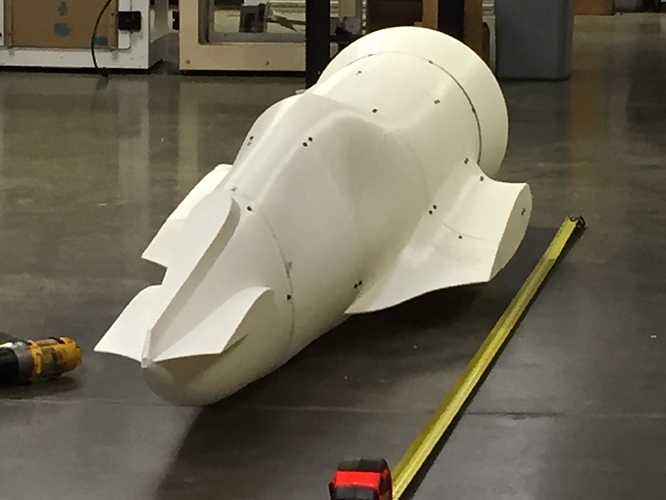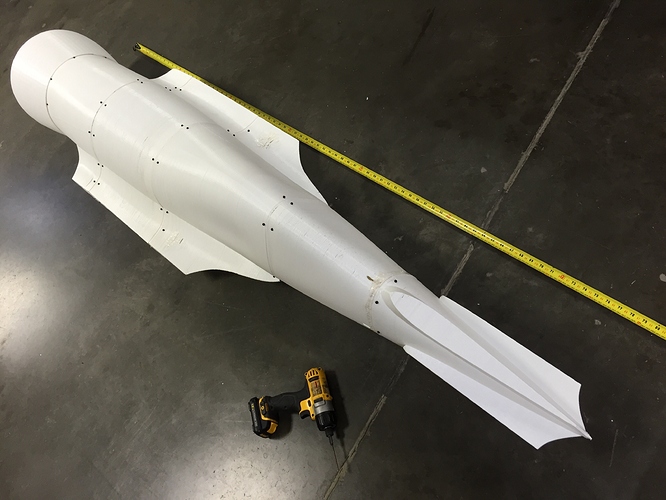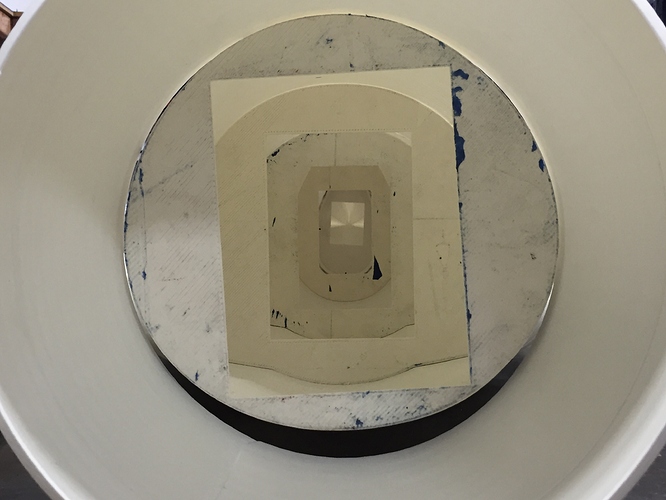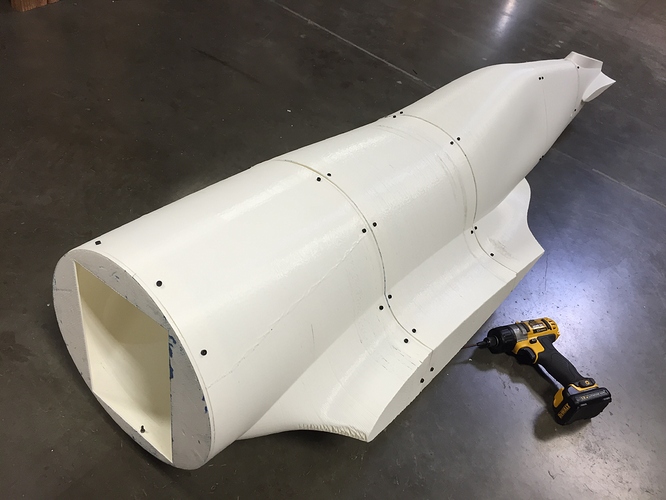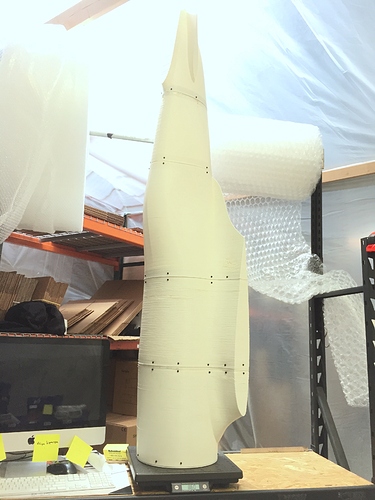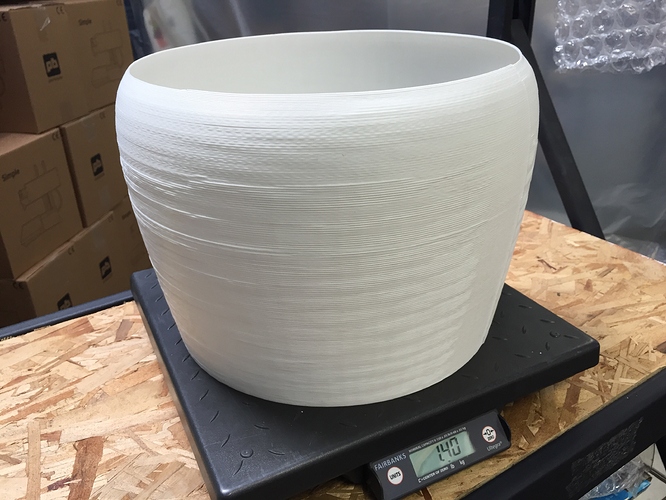Originally shared by Brook Drumm
The Printrbot Hughes H1 Racer designed by Andre Roy is coming along!
*Crazy long post ahead. You’ve been warned!
I’ve been slow to show the prints because there are definitely problem areas and learning that comes along with printing on the Printrbot Big-E… 1mm tip, .8mm layer height, single wall prints at 50mm/sec (if memory serves). But while some sections are rough, it’s just too cool not to share. You are getting the down and dirty real deal here.
We where getting great prints, all things considered, until we switched to 5 or 10kg rolls from Breathe 3D. I love there PLA++ but the machine was resonating badly pulling the weight of the spoils, so we built a powered filament motor setup that needs dialing in. Some walls suffered from our experimentation.
Being the impatient hacker that I am, I just said screw it and continued printing… Nothing that a skin coat of bongo can’t hide ;). So far, the fuselage with cowl is 10lbs… So I’ll have to add maybe 3-5 lbs of bondo to cover my sins… That may push this first test print over the edge to a non-flying display piece, but no matter, I can print more. I figure we’ll crash the final one (I’ve never built s plane, quadcopter or rc car I didn’t crash  so having a display piece may be nice.
so having a display piece may be nice.
The yet-to-be-built internal structure will bear the load and the wings so it will get much heavier. Retractable gear, ridiculously huge electric motor ($???), and all the trimmings will certainly be daunting to get airborne. I’ll have an experienced pilot fly the thing. Maybe I’ll get to take the controls between takeoff and landing though.
Andre is designing this in his spare time, and we would love help! He traced the profiles from original drawings we found online - ok, they might have been of a replica, don’t remember. He is working in Fusion 360, so other contributors can apply and jump in if approved. My jr mechanical engineer has cut the model into sections and designed bulkheads to piece the single wall sections together. We have to allow access to the length of the interior to figure out how the skin will be joined to the internal plywood structure. That will be a double layer scaffolding of 6mm birch plywood that we laser cut. The wing soars will be the same.
I test printed the wings in a smaller scale (1/8th I think) as s single piece. Two wings and one fuselage let me see how it was going to look. A bunch of work yet to go on the wings since we now have to incorporate off the shelve retractable gear and control surfaces and gear.
This is one of those projects that you undertake despite the fact that you have little idea of what the heck you are doing or if it can even be done. My favorite. It has really served as a way to get to know the quirks of the Big-E.
Andre is much more scientific than I am- doing fancy equations, testing wing profiles in software for lift and keeping tabs on estimated weight. I’m in good hands. He’s in Canada with design know-how and I’m in California, with printers, filament and more r&d money than brains. A good fit I think. I love working w talented people and never let distance get in the way. I offered him a printer but he has limited space - the Big-E requires a lot of that. I sent him a Printrbot Go Large back in the day and he designed a big flying wing on that, mixing 3D printing with traditional model building techniques.
I thought I’d be able to make this 100% 3D printed, and maybe I could, but we dropped to using laser cut wood for the internal structure to save time. I think it’s more appropriate. Maybe I’ll loop back and replace the frame and wing spars on a smaller scale version later. Who has s printer this big anyway!?
I was looking for reasons to own a Big-E… Trying to match use-cases with a printer that can print 3’x8’x6’ (in this revision) but as I progress, it makes more sense to redesign another version of the printer that is more like 3’x3’x3’ or 1 meter cubed so you could keep it in your garage and maybe still park your car! In fact, I’d probably shrink it down further on the X axis to allow you to get it through a standard door. This model, with how we cut it up, would work at 2’x2’x2’ I think… That’s close, anyway.
The nice thing about this printer is that we sell the metal parts as a cheap kit that ships in a small box. You self-source rails and all the bits and bobs. This gets around shipping nightmares. It also has resulted in no real sales, but I don’t care. There’s learning to be had! Some have requested an all-inclusive Kit for one-stop shopping. I may do that once I size the machine down to a more sane size.
The take-away from playing with the Big-E is two, maybe three, fold.
-
you must design your own model to explore “thin” wall prints and design. No infill and no support is palatable at these sizes. Spiral prints are best and there are some neat tricks you can employ to make the most of the fast speed while still getting rigid internal structures that are still spiral prints but with walls fusing together over microscopic gaps. You really have to learn how your slicer treats thick walls and how your printer over-extrudes or, maybe more accurately, how the filament layer sags and grows in width as it cools under the tug of gravity.
-
filament at this scale becomes very expensive. As do mistakes. I only have a handful of waste (maybe 30 lbs) but that’s probably $500 + precious time. I designed this thing to eventually have a pellet extruder to alleviate that particular pain. But I have not made good progress on that, beyond some drawings and early alpha tests. Once I build a shredder and that pellet extruder, it’s on!!
-
3D printing at this size, with truly no practical boundaries on size is a freakin superpower! I have been surprised with the amount of times I have faced a problem on a side project and said “let’s just printing on the Big-E”. Ok, I’ve said it more than I’ve done it, but that’s mostly due to my crazy lifestyle, busy schedule and flood of stupid, but entertaining, ideas and side projects. Bottom line, we haven’t even scratched the surface of what is possible.
One last note before getting to the pictures… Printing big, these large format printers, are definitely becoming more popular. As people get comfortable with 3D printing, more demand to go larger and larger has emerged. I haven’t talked that demand yet, due to taking so long to perfect this printer. But while large format printers are becoming a thing, a couple barriers have emerged: cost, size and realistic expectations. The Big-E addresses the first two by leveraging off the shelf extrusion and absolute minimum rigidity with the whole printer crawling across aluminum extrusion you lay down on the floor. It’s completely modular and ends up feeling smaller than it really is by being so thin in the z axis. It’s not a cube. You set it up on the floor so no big table required. It fits through a door when taken off its y rails. This, however, yields minimum rigidity and lowers the print speed and produces less than perfect prints. Which makes the expectations of what it can do pretty wonky as compared to a desktop printer. But I think you have to shift your thinking a bit when printing big. Yes, I’ll be able to improve rigidity and raise the speed and printing resolution, but you absolutely do NOT need the resolution of s desktop printer. At least I don’t. I need structural parts and it’s ok w me to have them be a little ugly. You csnt use infill like a desktop printer does. Weenie little parts w a mind-blowing finish and incredible detail are not a strong suit for this machine. But if you design a part from the beginning with the goal of little to zero infill, instead making use of crazy strong walls, it’s magic. So give some thought as to whether or not your use case is a good match for printing huge… It comes at the price of thoughtful design.
I’ve been tempted to print a statue of myself using a full body scan I have, but that would be a stupid marketing ploy. One company has done it already and held a record for 5 minutes… Congratulations. Life size motorcycles and art pieces like that are neat but I just can’t see myself doing that. I’ll leave that to others. I’m way more intrigued by printing functional things… Solving real problems. The cost of a self-indulgent print keeps frivolous prints at bay for now. But I’m not promising anything. I’m fairly impulsive, after all.
Even though I own a 3D printer manufacturing business, these machines have a place. You can’t print anything in plastic and end up with a functional part. You should Cnc some stuff, laser cut others, and hand-make the rest. Welding metal is hard to compete with, for one example. But there is still a place for prototyping in 1:1 scale. I talked to the owner of EV West last week (another story) and he built a 3D printer to print scale models of larger parts. Very cool, right!? But how much better would it be to print a dimensionally accurate prototype, like an engine mount, and fit it directly to the electric car. Now that’s livin’. And, btw, it would save time and money… Lots of it. Which reminds me I need to send him a scaled down Big-E!
So most of you have no need for something like this, I get it. In fact, I agree! But there are a few of you out there that A) really do have use for this or B) have disposable income and time to dream up some insane project that you have had bouncing around in your head. If that’s you, jump in. Build your own big printer. Get my files and riff off of my half-baked ideas or order a kit. I’m telling you, it’s pretty cool.
I used to have the only 3D printer on the block (maybe in my whole town). Then I had the least expensive printer anywhere. Then I had the most reliable one around (arguably). Hopefully soon, I will have the easiest to use 3D printer. But for now, one thing is for sure: I have the biggest freakin printer I’ve ever seen in person… And I got the prints to prove it!
Self-indulgently yours,
Brook
Printrbot
